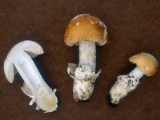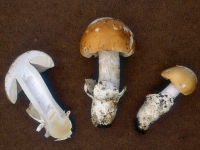
Amanita velosa
Encyclopedia
Amanita velosa is an edible
species of agaric
found in California
, as well as Oregon
and Baja California
.
section Vaginatae, and like other species in this group, it is characterized by its lack of an annulus
, striate pileus
margin, thick universal veil
remnants comprising the veil, volva
, and pileus patches, inamyloid spores, and lack of characteristic Amanita toxins such as amatoxins and ibotenic acid
. It is distinguished from other species in section Vaginatae by its lack of any kind of umbo
on its pileus, its short pileus striae, and its distinct pale orange to pale salmon coloration when young. Its coloration can become more brownish with age and entirely white specimens are occasionally seen as well. Like many other Amanita, the gills are white, but occasionally have a distinct pinkish or orangish tint. In older specimens, the odor can become pungent and fishy.
. Its favored habitat is the ecotone
between oak
(particularly coast live oak
) woodlands and open grassland, living in an ectomycorrhizal relationship with young oak trees.
Although this species is primarily known from the coastal regions of California, Oregon, and Baja California, it is also reported to have been found in association with aspen
and conifers in the Sierra Nevada and there is also one report of this species being found growing with spruce
in the Great Smoky Mountains National Park
, in the eastern United States.
 It is considered to be an outstanding edible species with a distinctively sweet or nutty flavor. However, great caution must be exercised to properly identify it, as the deadly Amanita ocreata
It is considered to be an outstanding edible species with a distinctively sweet or nutty flavor. However, great caution must be exercised to properly identify it, as the deadly Amanita ocreata
(and occasionally Amanita phalloides) is also found in the same habitat at the same time of year, and can often be found in close proximity to each other. A. ocreata and A. phalloides have thin universal veil remnants, a sac-like volva, an annulus, a non-striate pileus margin, and a pileus that is a different color than A. velosa. These differences can fade as the fruiting body ages, making it important to collect only specimens that have all of their identifying characteristics intact. Some authorities go so far as to say no Amanita should be considered for eating.
Edible mushroom
Edible mushrooms are the fleshy and edible fruiting bodies of several species of fungi. Mushrooms belong to the macrofungi, because their fruiting structures are large enough to be seen with the naked eye. They can appear either below ground or above ground where they may be picked by hand...
species of agaric
Agaric
An agaric is a type of fungal fruiting body characterized by the presence of a pileus that is clearly differentiated from the stipe , with lamellae on the underside of the pileus. "Agaric" can also refer to a basidiomycete species characterized by an agaric-type fruiting body...
found in California
California
California is a state located on the West Coast of the United States. It is by far the most populous U.S. state, and the third-largest by land area...
, as well as Oregon
Oregon
Oregon is a state in the Pacific Northwest region of the United States. It is located on the Pacific coast, with Washington to the north, California to the south, Nevada on the southeast and Idaho to the east. The Columbia and Snake rivers delineate much of Oregon's northern and eastern...
and Baja California
Baja California
Baja California officially Estado Libre y Soberano de Baja California is one of the 31 states which, with the Federal District, comprise the 32 Federal Entities of Mexico. It is both the northernmost and westernmost state of Mexico. Before becoming a state in 1953, the area was known as the North...
.
Description and classification
It is part of AmanitaAmanita
The genus Amanita contains about 600 species of agarics including some of the most toxic known mushrooms found worldwide. This genus is responsible for approximately 95% of the fatalities resulting from mushroom poisoning, with the death cap accounting for about 50% on its own...
section Vaginatae, and like other species in this group, it is characterized by its lack of an annulus
Annulus (mycology)
An annulus is the ring like structure sometimes found on the stipe of some species of mushrooms. The annulus represents the remaining part of the partial veil, after it has ruptured to expose the gills or other spore-producing surface. An annulus may be thick and membranous, or it may be cobweb-like...
, striate pileus
Pileus (mycology)
The pileus is the technical name for the cap, or cap-like part, of a basidiocarp or ascocarp that supports a spore-bearing surface, the hymenium. The hymenium may consist of lamellae, tubes, or teeth, on the underside of the pileus...
margin, thick universal veil
Universal veil
In mycology, a universal veil is a temporary membranous tissue that fully envelops immature fruiting bodies of certain gilled mushrooms. The developing Caesar's mushroom , for example, which may resemble a small white sphere at this point, is protected by this structure...
remnants comprising the veil, volva
Volva (mycology)
The volva is a mycological term to describe a cup-like structure at the base of a mushroom that is a remnant of the universal veil. This macrofeature is important in wild mushroom identification due to it being an easily observed, taxonomically significant feature which frequently signifies a...
, and pileus patches, inamyloid spores, and lack of characteristic Amanita toxins such as amatoxins and ibotenic acid
Ibotenic acid
Ibotenic acid is a chemical compound that is naturally occurring in the mushrooms Amanita muscaria and Amanita pantherina, among others...
. It is distinguished from other species in section Vaginatae by its lack of any kind of umbo
Umbo (mycology)
thumb|right|[[Cantharellula umbonata]] has an umbo.thumb|right|The cap of [[Psilocybe makarorae]] is acutely papillate.An umbo is a raised area in the center of a mushroom cap. Caps that possess this feature are called umbonate. Umbos that are sharply pointed are called acute, while those that are...
on its pileus, its short pileus striae, and its distinct pale orange to pale salmon coloration when young. Its coloration can become more brownish with age and entirely white specimens are occasionally seen as well. Like many other Amanita, the gills are white, but occasionally have a distinct pinkish or orangish tint. In older specimens, the odor can become pungent and fishy.
Habitat and range
Amanita velosa is a late-season mushroom in its range of occurrence, being found from midwinter into spring, up until the end of the California rainy seasonWet season
The the wet season, or rainy season, is the time of year, covering one or more months, when most of the average annual rainfall in a region occurs. The term green season is also sometimes used as a euphemism by tourist authorities. Areas with wet seasons are dispersed across portions of the...
. Its favored habitat is the ecotone
Ecotone
An ecotone is a transition area between two biomes but different patches of the landscape, such as forest and grassland. It may be narrow or wide, and it may be local or regional...
between oak
Oak
An oak is a tree or shrub in the genus Quercus , of which about 600 species exist. "Oak" may also appear in the names of species in related genera, notably Lithocarpus...
(particularly coast live oak
Coast Live Oak
Quercus agrifolia, the Coast Live Oak, is an evergreen oak , native to the California Floristic Province. It grows west of the Sierra Nevada from Mendocino County, California, south to northern Baja California in Mexico. It is classified in the red oak section Quercus agrifolia, the Coast Live Oak,...
) woodlands and open grassland, living in an ectomycorrhizal relationship with young oak trees.
Although this species is primarily known from the coastal regions of California, Oregon, and Baja California, it is also reported to have been found in association with aspen
Aspen
Populus section Populus, of the Populus genus, includes the aspen trees and the white poplar Populus alba. The five typical aspens are all native to cold regions with cool summers, in the north of the Northern Hemisphere, extending south at high altitudes in the mountains. The White Poplar, by...
and conifers in the Sierra Nevada and there is also one report of this species being found growing with spruce
Spruce
A spruce is a tree of the genus Picea , a genus of about 35 species of coniferous evergreen trees in the Family Pinaceae, found in the northern temperate and boreal regions of the earth. Spruces are large trees, from tall when mature, and can be distinguished by their whorled branches and conical...
in the Great Smoky Mountains National Park
Great Smoky Mountains National Park
Great Smoky Mountains National Park is a United States National Park and UNESCO World Heritage Site that straddles the ridgeline of the Great Smoky Mountains, part of the Blue Ridge Mountains, which are a division of the larger Appalachian Mountain chain. The border between Tennessee and North...
, in the eastern United States.
Edibility and identification

Amanita ocreata
Amanita ocreata, commonly known as the death angel, destroying angel, angel of death or more precisely Western North American destroying angel, is a deadly poisonous basidiomycete fungus, one of many in the genus Amanita. Occurring in the Pacific Northwest and California floristic provinces of...
(and occasionally Amanita phalloides) is also found in the same habitat at the same time of year, and can often be found in close proximity to each other. A. ocreata and A. phalloides have thin universal veil remnants, a sac-like volva, an annulus, a non-striate pileus margin, and a pileus that is a different color than A. velosa. These differences can fade as the fruiting body ages, making it important to collect only specimens that have all of their identifying characteristics intact. Some authorities go so far as to say no Amanita should be considered for eating.

